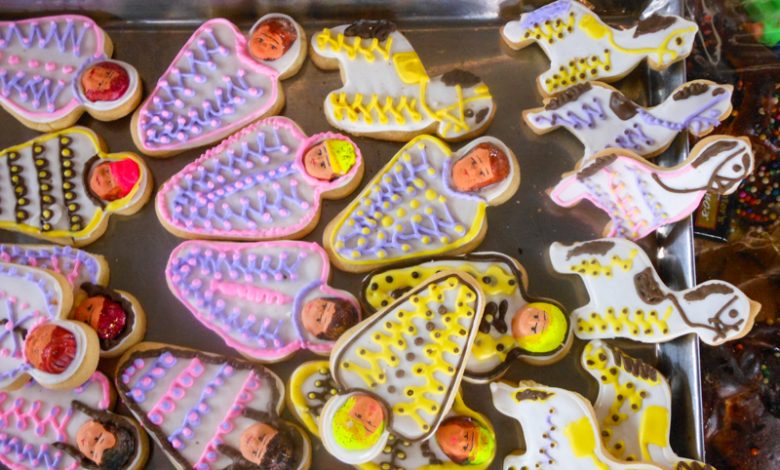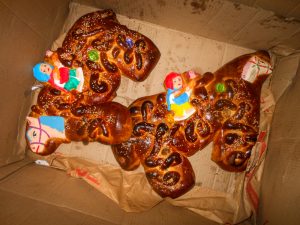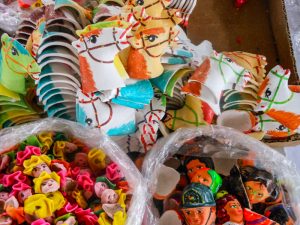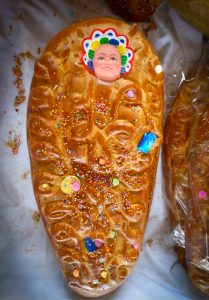Pan Wawas (Bread Babies) Are Surprisingly Complex (Part I of II)

Bread, risen and sweet, is a common symbol on November first when Christians celebrate the souls of all the dead saints, followed by a day for all the holy departed. The miracle of leavening breathes into bread the idea of a resurrection from the dead and salvation, key Christian ideals. Yet in Cuzco, though the common bread finds a place on this day, it takes different meanings in the distinctive culture of the Andes.
Cuzco’s sweet bread does not quite come in the diversity of shapes it does in Mexico, where the Pan de Muertos is an important food on this Day when Mexicans share a meal with their departed. While the Andean customs hold similarities with Mexico– feeding the dead and the important symbolism in bread from a common Catholic tradition–in Cuzco the bread takes just two important shapes: a horse with a ladder, and a baby wrapped up in cloth to make a bundle.
This set of two forms of bread is already molded by a very important principle of Cuzco’s social life and hence its culture, that is dualism. Just as twenty four hours encompass both night and day, and the city has a Plaza de Armas and one of Regocijo, so too do people come in two forms: female and male.

The breads index these genders. The child is given to girls while the horse is reserved for boys.
This is more than giving children a gift. It is an example of an important norm in Cuzco society, the giving of gifts to people. People give each other lots of gifts.

When you visit someone you should never “arrive with your hands empty” people say. You should always take a gift. Gifts might be bottles of beer. They might also be food one brings from somewhere else one has traveled, or they could be (this time of year) gifts of bread babies.
Unlike elsewhere where the focus rests on the gift given and its intrinsic characteristics, such as scarcity, uniqueness, value, or status, even though those things still might be important in Cuzco, the focus rests in the Imperial City on the act of giving.
In some cases, such as when you visit someone, they may respond in a dualist turn, by offering you something to eat and / or drink. The gift is met with another gift. Through them a sharing takes place. It brings the dualism into something greater, some sort of unity, or whole, such as a family or a set of friends, or just what in Cuzco they simply call comensales, the people who sit around a common table (or space) and share a common meal.
The comensales are more than the “diners” that dictionaries would have you take as the translation. In Cuzco they are people who in the act of sitting down together and eating shared food and drinking shared drink attain a togetherness, a whole, even if it only lasts for the minute of the visit or the meal.
Bread Babies all Wrapped up. (Photo: Wayra
When people make the gift of bread to their children, unlike when they take it to their friends, there is no return expected in any immediate fashion. The children receive it and can eat it, share it, or wait for later days.
Here a different point appears. The parents are giving the girl something that represents the fertility they hope she will have when she reaches maturity and will produce her own babies. They are the gift to the family.
That the babies are wrapped in a carrying cloth, suggests the importance of cloth as a symbol of being part of society, of making new borns and strangers into the kinds of people with whom you share ayni (mutual support and assistance). You help each other and you feast together.
This gift is like the gift of bread–a different kind of sweet bread composed of two parts, one baked on top the other, called pan jurqa–that is given by people who issue the request / obligation of a person to sponsor a feast or to play an important role in one.
Both use the action of making a gift of bread, something sweet and something risen, in order to build an obligation or to entice the person to play a role. While for the jurqa it is the sponsorship of a feast, for the children it is the role of being and becoming. Being a socialized child, encompassing the values made into the bread, and becoming an adult in terms of the roles provided.
The gift is a different form of the reality people traditionally think the children need. The baby is a key to being a mother and the horse to being a man with transportation and the ability to go into the world beyond the home to make a living.
Of course these ideals are stereotyped and real life is far more complex. Boys may raise children and girls often go out into the world. Nevertheless, the norms play an important role; they manifest hopes and characterize the way in which dualism shapes the Andean universe.

In the Andes there is a long history of miniatures, Some of these are called illas or conopas, and some are like the small houses, trucks, and certificates one can purchase at the shrines of Huanca or in Qoyllur Rit’i. They are expected to grow and become the thing desired. In this, they are both a tangible manifestation of a desire, and a means of obtaining what is desired if you nourish it ritually through sharing drink, coca, and so on.
Of course people also buy omens, augeries, to bring them what they hope for. They use the augeries as both desires, and means. I am thinking of things such as the sheaves of wheat that people hang on their walls, as well the cactus spines.
The bread babies are both miniatures that can grow and augueries that can both speak to hope and perhaps create. But unlike the illas and miniatures, the bread babies are eaten. Like the pan jurqa, they involve ingesting the relationships and ideals contained in the bread. We shall discuss this in the next post on bread.





